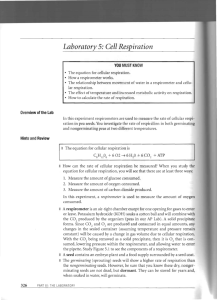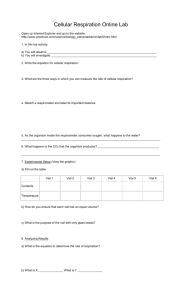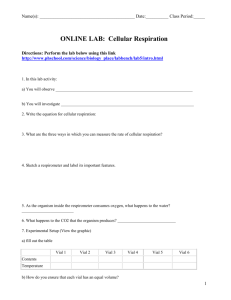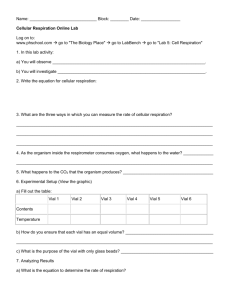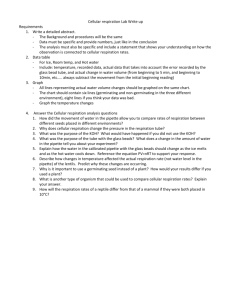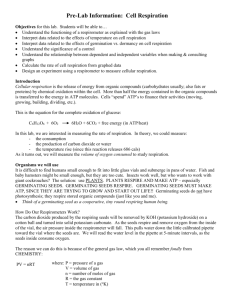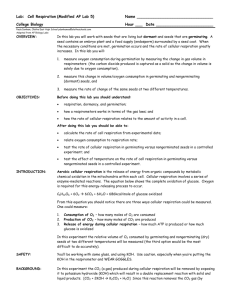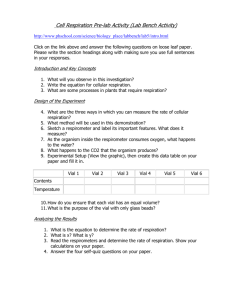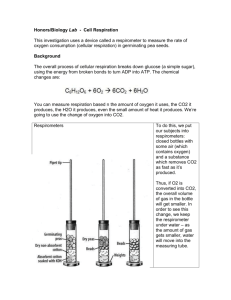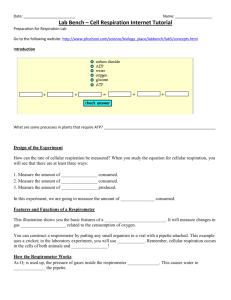Lab: Cell Respiration (Modified AP Lab 6) OVERVIEW: In this lab
advertisement
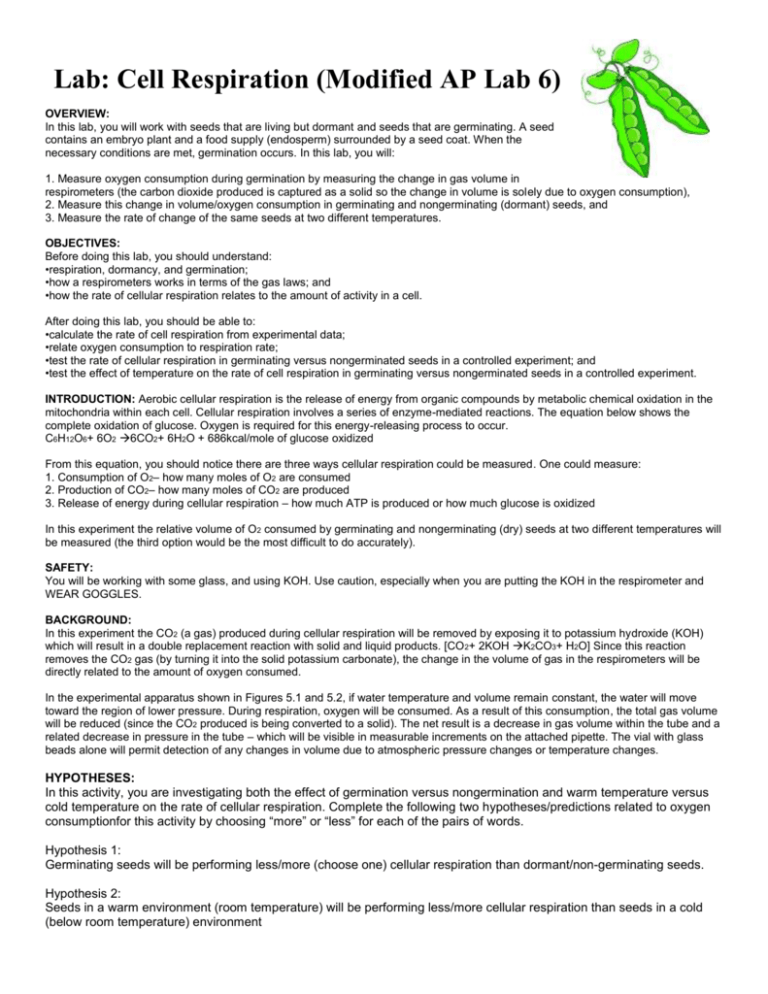
Lab: Cell Respiration (Modified AP Lab 6) OVERVIEW: In this lab, you will work with seeds that are living but dormant and seeds that are germinating. A seed contains an embryo plant and a food supply (endosperm) surrounded by a seed coat. When the necessary conditions are met, germination occurs. In this lab, you will: 1. Measure oxygen consumption during germination by measuring the change in gas volume in respirometers (the carbon dioxide produced is captured as a solid so the change in volume is solely due to oxygen consumption), 2. Measure this change in volume/oxygen consumption in germinating and nongerminating (dormant) seeds, and 3. Measure the rate of change of the same seeds at two different temperatures. OBJECTIVES: Before doing this lab, you should understand: •respiration, dormancy, and germination; •how a respirometers works in terms of the gas laws; and •how the rate of cellular respiration relates to the amount of activity in a cell. After doing this lab, you should be able to: •calculate the rate of cell respiration from experimental data; •relate oxygen consumption to respiration rate; •test the rate of cellular respiration in germinating versus nongerminated seeds in a controlled experiment; and •test the effect of temperature on the rate of cell respiration in germinating versus nongerminated seeds in a controlled experiment. INTRODUCTION: Aerobic cellular respiration is the release of energy from organic compounds by metabolic chemical oxidation in the mitochondria within each cell. Cellular respiration involves a series of enzyme-mediated reactions. The equation below shows the complete oxidation of glucose. Oxygen is required for this energy-releasing process to occur. C6H12O6+ 6O2 6CO2+ 6H2O + 686kcal/mole of glucose oxidized From this equation, you should notice there are three ways cellular respiration could be measured. One could measure: 1. Consumption of O2– how many moles of O2 are consumed 2. Production of CO2– how many moles of CO2 are produced 3. Release of energy during cellular respiration – how much ATP is produced or how much glucose is oxidized In this experiment the relative volume of O2 consumed by germinating and nongerminating (dry) seeds at two different temperatures will be measured (the third option would be the most difficult to do accurately). SAFETY: You will be working with some glass, and using KOH. Use caution, especially when you are putting the KOH in the respirometer and WEAR GOGGLES. BACKGROUND: In this experiment the CO2 (a gas) produced during cellular respiration will be removed by exposing it to potassium hydroxide (KOH) which will result in a double replacement reaction with solid and liquid products. [CO 2+ 2KOH K2CO3+ H2O] Since this reaction removes the CO2 gas (by turning it into the solid potassium carbonate), the change in the volume of gas in the respirometers will be directly related to the amount of oxygen consumed. In the experimental apparatus shown in Figures 5.1 and 5.2, if water temperature and volume remain constant, the water will move toward the region of lower pressure. During respiration, oxygen will be consumed. As a result of this consumption, the total gas volume will be reduced (since the CO2 produced is being converted to a solid). The net result is a decrease in gas volume within the tube and a related decrease in pressure in the tube – which will be visible in measurable increments on the attached pipette. The vial with glass beads alone will permit detection of any changes in volume due to atmospheric pressure changes or temperature changes. HYPOTHESES: In this activity, you are investigating both the effect of germination versus nongermination and warm temperature versus cold temperature on the rate of cellular respiration. Complete the following two hypotheses/predictions related to oxygen consumptionfor this activity by choosing “more” or “less” for each of the pairs of words. Hypothesis 1: Germinating seeds will be performing less/more (choose one) cellular respiration than dormant/non-germinating seeds. Hypothesis 2: Seeds in a warm environment (room temperature) will be performing less/more cellular respiration than seeds in a cold (below room temperature) environment PROCEDURE: 3 respirometers should be set up for each group to put in eachtray at each temperature– Respirometer 1: germinating/moist grass seeds (5.00 g dry mass) Respirometer 2: dormant/dry grass seeds (5.00 g dry mass) Respirometer 3: 20 medium glass beads (5.00 g dry mass) 1. Select roles for your collaborative lab group-facilitator, recorder, reporter, and materialist. 2. The two temperatures for the water baths should be room temperature and 10 degrees (C)– use ice to lower the temperature of the second set of water baths. Be sure to record these temperatures in the titles for your data tables. 3. To assemble the respirometers obtain 3 vials, each with stopper and attached pipette – be careful not to dislodge the pipette or break the seal between the pipette and the stopper since any leaks will result in data inaccuracies. Make sure your vials are dry on the inside. Place a small piece of absorbent cotton in the bottom of each vial (take care to use the same amount in all 3 vials).Taking care not to get any KOH on the sides of the vial, moisten the cotton with 3 drops of 15% KOH using a thin stem pipette. Be sure to replace the lid on your KOH so it does not absorb CO2 from the air. 4. Now, add an equally small piece of non-absorbent rayon cotton (to protect your seeds from the KOH). 5. Place the germinating seeds, dry seeds, and beads in vials 1, 2, and 3, respectively as pictured in Figure 5.1. Insert the stopper fitted with the calibrated pipette. Vial 1 received 15 germinating peas (calculate the volume), Vial 2 receives 15 germinating peas and glass beads to equal the volume of Vial 1, and Vial 3 receives glass beads that total the germinating peas volume. 6. See Figure 5.2. Make a sling of masking tape attached to each side of the water bath to hold the pipettes out of the water during an equilibration period of 10 minutes. Place the respirometers as illustrated in Figure 5.2. Use a weight at the junction of the pipettes and stoppers to hold the respirometers under water. 7. AFTER an equilibration period of 10 minutes, place a drop of water with red dye in each respirometer tip then remove the masking tape and lower the tips of the respirometers into the water bath – take care NOT to lift the vials out of the water – you do not want to change the temperature of the respirometers when lowering them. Make sure respirometers are fully submerged in the water baths. Water will enter the pipettes for a short distance and then should appear to stop – if water continues to move in check for leaks in the respirometer. Work swiftly and arrange respirometers so that the pipettes can be read through the water. Keep your hands out of the water after the experiment has begun and strive to maintain a constant temperature in the water. 8. Allow the respirometers to equilibrate for three more minutes and then record, to the nearest 0.01mL, the initial position of water in each pipette (= time 0 value). Check the temperature every 5 minutes and record it in title for Table 5.1. Columns A, C, and F are for recording your raw data – the other columns are calculated values. DATA: ANALYSIS OF RESULTS: 1. Graph the class means in your lab report for the germinating and dry seeds at the two temperatures on the graph below. Use a different color for each type of seed at each temperature (4 colors), be sure to include a title and a legend for your graph and label your axes (your independent variable should be on the x-axis). Once your points (for times 0, 5, 10, 15, and 20) are plotted, draw an approximate “line of best fit“for each set of data (you will have 4 lines – you may find it easier/better to use your calculator or Excel to find the lines of best fit). **Based on your graph describe and explain the relationship between the amount of oxygen consumed and time. 2. In Table 5.3 below, record the rate of O2 consumption of the seeds for all four (4) lines from the above graph. (The rate of consumption should be the slope of each of the lines (Δy/Δx). Show your calculations in the first column and record the final rate value in the last column. Conclusion: Follow the three-paragraph prompt found in your syllabus. Make sure to accept or reject your hypotheses and include discussions of the results.

